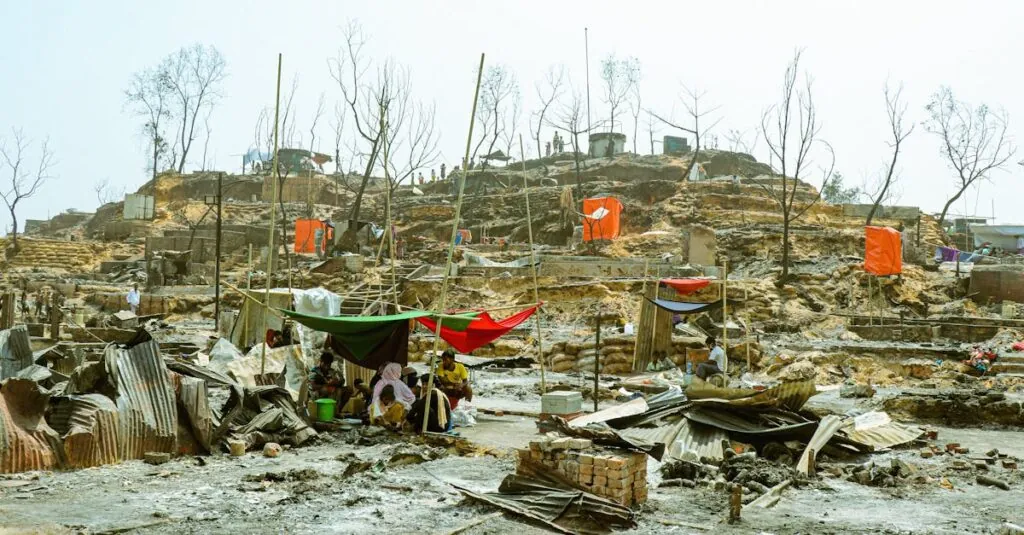Table of Contents
ToggleResettlement might sound like a fancy term for moving day, but it’s so much more than that. Imagine packing up your life and relocating to a new place where everything is different—food, culture, and maybe even the weather. For many, this isn’t just a change of scenery; it’s a lifeline. Resettlement plays a crucial role in helping individuals and families find safety and a fresh start, often after facing unimaginable challenges.
But let’s be real. Moving can be a pain, even when it’s for a good reason. From navigating paperwork that feels like it’s written in ancient hieroglyphics to figuring out how to fit your entire life into a few boxes, the process can be overwhelming. Yet, the rewards of resettlement—new opportunities, community, and hope—make every hurdle worth it. Join the journey of understanding what resettlement truly means and why it matters so much.
Overview of Resettlement
Resettlement represents a structured process where individuals or families relocate to a new environment, often due to conflict, persecution, or natural disasters. This procedure aims to provide safety and security for those affected. Often, governments and international organizations play crucial roles in facilitating this movement, ensuring that necessary support is available.
Examples include refugees and internally displaced persons who face immediate threats in their home countries. Challenges during resettlement frequently involve bureaucratic hurdles and cultural adjustments. Understanding these aspects is essential for ensuring a smooth transition.
Statistics reveal that an estimated 26 million refugees globally sought resettlement in 2022, highlighting the urgent need for comprehensive support systems. New opportunities arise in host countries, offering access to education, employment, and healthcare. Communities benefit when resettled individuals contribute their skills and experiences.
Connecting with local support networks can significantly enhance the resettlement experience. Trust-building with organizations such as the United Nations High Commissioner for Refugees can lead to additional resources and assistance. The emotional impact on resettled individuals often includes a strong desire for stability and a chance to rebuild their lives.
Barriers exist but addressing these challenges can lead to successful integration. Prioritizing mental health and community engagement plays a critical role in this process. As communities welcome resettled individuals, fostering compassion and understanding enhances the overall social fabric.
Types of Resettlement
Resettlement can occur in various forms, reflecting the circumstances and needs of individuals and families. Understanding these types helps in creating tailored support systems.
Voluntary Resettlement
Voluntary resettlement occurs when people choose to relocate, often seeking better living conditions or opportunities. Jobs, education, and healthcare often motivate these individuals. Personal choice plays a central role in this process. For example, some might move from rural areas to urban centers for improved economic prospects. This type allows for greater agency, making the transition smoother. Effective planning and community involvement can enhance the experience of voluntary resettlement.
Involuntary Resettlement
Involuntary resettlement takes place when individuals are forced to leave their homes due to external factors. Conflict, natural disasters, and development projects frequently drive this type. The experience often comes with significant trauma and loss. Individuals may face challenges such as inadequate displacement support and lack of integration resources. For instance, refugees fleeing war-torn regions often encounter bureaucratic obstacles. Addressing these issues requires coordinated efforts among governments and organizations, focusing on immediate relief and long-term stability.
Key Challenges in Resettlement
Numerous challenges accompany resettlement, impacting individuals and communities alike. Economic barriers and social integration require careful consideration.
Economic Factors
Economic challenges often hinder successful resettlement. Access to employment opportunities remains a primary concern. Wage disparities exist between resettled individuals and local populations, making financial stability elusive. Job training programs can mitigate these issues, offering skills necessary for workforce integration. Factors such as language barriers and lack of recognition for foreign qualifications complicate the process. Many resettled individuals navigate these hurdles without adequate support, exacerbating their financial insecurities. Ultimately, addressing economic factors is essential for fostering sustainable livelihoods and enhancing the overall resettlement experience.
Social Factors
Social integration plays a significant role in the resettlement journey. Newcomers frequently encounter cultural differences that create barriers to interaction with local communities. Missing social networks amplifies feelings of isolation, affecting mental well-being. Support from established community organizations can ease this transition, fostering connections and mutual understanding. Programs promoting cultural exchange often facilitate smoother integration, helping newcomers become more familiar with local customs. Effective communication serves as a bridge, enabling better relationships between resettled individuals and local residents. Overcoming social challenges is vital for building cohesive communities and ensuring successful resettlement outcomes.
Successful Resettlement Case Studies
Various successful resettlement case studies illustrate the effectiveness of structured processes. One notable example involves refugees from Syria who resettled in Canada. Integrating into Canadian society, they accessed language training, job opportunities, and community support, resulting in positive social and economic outcomes.
Another example features South Sudanese individuals relocated to the United States. In this case, local organizations provided mentorship and resources, enabling them to overcome cultural barriers. Successful connections with the community fostered belonging and improved mental health.
The experience of Guatemalan refugees in Mexico highlights effective resettlement through collaborative efforts. Local governments partnered with NGOs to offer training programs and education. This collaboration enhanced the newcomers’ skills, supporting their transition and integration.
Data from the UNHCR indicates that successful resettlement contributes significantly to economic growth in host countries. In 2022, countries that embraced resettlement observed increased workforce diversity, which spurred innovation and entrepreneurship. With proper support systems, individual contributions extended beyond economic benefits, enriching cultural landscapes in host communities.
Resettlement programs often focus on shared success stories to inspire others. For instance, stories highlighting young immigrants excelling in academics and contributing to local economies emphasize resilience. Such narratives encourage community engagement and promote mutual understanding.
Each case demonstrates the importance of tailored programs addressing specific needs. A localized approach, emphasizing cultural sensitivity and awareness, promotes effective integration for resettled individuals. Successful resettlement relies on strategic partnerships, proactive support, and a commitment to creating inclusive environments.
Resettlement is a complex journey filled with challenges and opportunities. As individuals and families seek safety and a new beginning, the importance of structured support cannot be overstated. Collaborative efforts among governments, organizations, and communities are essential to ensure successful integration.
By addressing economic and social barriers, fostering compassion, and promoting cultural exchange, communities can transform the resettlement experience into one of hope and belonging. Each successful resettlement story highlights the resilience of those involved and the potential for mutual growth. Embracing this process not only enriches the lives of newcomers but also strengthens the social fabric of host communities.





